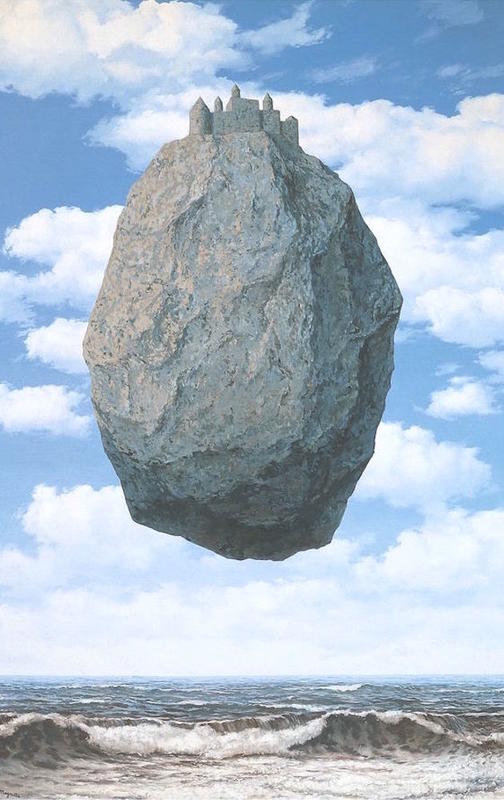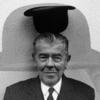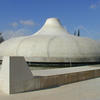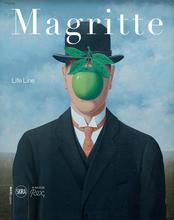More about The Castle of the Pyrenees
- All
- Info
- Shop

Contributor
Surrealism would have been harder to explain if not for the work of Rene Magritte.
He landed the psychological punch for the Surrealist rebellion. Without him, the most iconic reference to the movement would have been Dali’s melting clocks. Imagine the world of cinema without thrillers. Sure, there are a lot of cool movies out there but none that make you feel the way Hitchcock’s ‘The Birds’ does. Birds everywhere, attacking, creeping, killing. *Shudders.* Magritte made us feel that way, too.
Rene Magritte painted the Castle of the Pyrenees in 1959 for a gentleman named Harry Torczyner. He was a lawyer in New York. Rene and Harry were good friends. They met in 1958 and committed themselves to a long distance bromance until their deaths. The Israel Museum in Jerusalem, where the painting is currently housed, published a compilation of the letters they wrote to one another.
Magritte wanted Harry to pick the subject for this painting. The letters indicate that it was Harry who suggested the clear sky and the dark sea. He also chose the ginormous rock, topped with a *crossing my fingers* fully-functional castle. I'd move into that castle right away.
For Harry, the Castle of the Pyrenees evoked hope. What if it did more than that? There's so much we don't know about Harry Torczyner, but I do have a theory. The Pyrenees are a mountain range, much like the Himalayas or the Alps. It is situated between Spain and France, forming a natural border. Mother Nature, it seems, was pretty sure these countries would not get along. They didn't. They fought each other for 24 years. So what is it about Torczyner and the Pyrenees that we don’t know?
Harry Torcyzner fled from a Nazi camp in Berlin. I believe he crossed the Pyrenees to find asylum. Harry's escape route led him through France, Spain, and Cuba. Before he set sail for Cuba from Spain, Harry probably did cross the contentious mountain range. The painting, then, can symbolize the story of his escape. The towering mountain and the rough seas seem to be obstacles that Harry managed to overcome. This painting is a symbol of hope, and I hope you’re seeing what I’m seeing. I see a prophetic dream, like the visions described in the Bible.
Magritte would often say, "If a dream is a revelation about life in reality, then life, in reality, is also a revelation about a dream." This painting seems to have been Harry's reality, it only makes me wonder what he dreamt about. Maybe Magritte saw it. That's why they were buddies. They shared dreams. .
Sources
- Saxon, Wolfgang. "Harry Torczyner, 87, Lawyer, Writer and Promoter of Artists." The New York Times. April 13, 1998. Accessed May 16, 2019. https://www.nytimes.com/1998/04/13/arts/harry-torczyner-87-lawyer-write….
- Solomon-Godeau, Abigail. "Mad or Bad? Magritte's Artistic Rebellion." The Paris Review. May 18, 2018. Accessed May 16, 2019. https://www.theparisreview.org/blog/2018/05/14/mad-or-bad-magrittes-art….
- "The Castle of the Pyrenees, 1959." Henri Matisse. Accessed May 16, 2019. https://www.renemagritte.org/the-castle-of-the-pyrenees.jsp.
- "The Pipe and Secrets: Rene Magritte Quotes about the Imaginary and the Real." Arthive. Accessed May 16, 2019. https://arthive.com/publications/3651~The_pipe_and_secrets_Rene_Magritt….
Featured Content
Here is what Wikipedia says about The Castle of the Pyrenees
The Castle of the Pyrenees (French: Le Château des Pyrénées) is an oil on canvas painting by the Belgian surrealist René Magritte, completed in 1959. It is held at the Israel Museum, in Jerusalem.
Check out the full Wikipedia article about The Castle of the Pyrenees














I really enjoy The Castle of the Pyrenees because it reminds me of God's Kingdom and that God is our Rock. For me, this picture represents that God Himself is bigger and above any troubling wave that we encounter on earth. Any problem that happens or times when we feel that we are drowning - That God is that safe place that is free from the troubles.